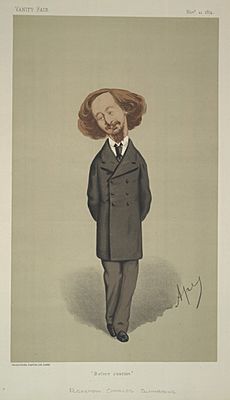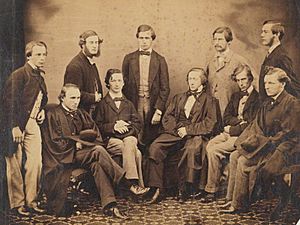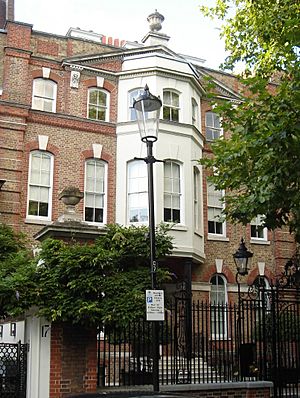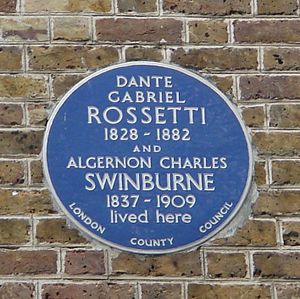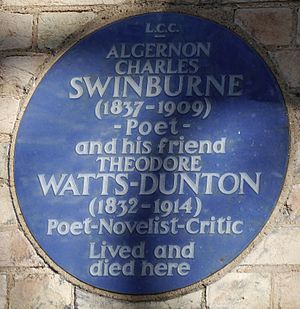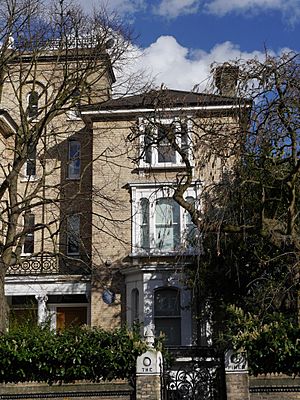Algernon Charles Swinburne facts for kids
Quick facts for kids
Algernon Charles Swinburne
|
|
|---|---|
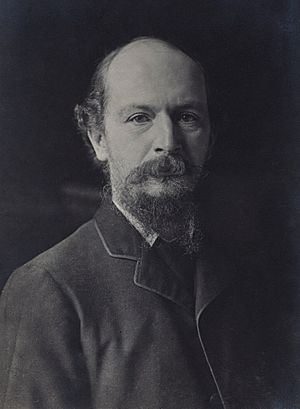
Swinburne aged 52
|
|
| Born | 5 April 1837 London, England |
| Died | 10 April 1909 (aged 72) London, England |
| Occupation | Poet, playwright, novelist, and critic |
| Education | Eton College |
| Alma mater | Balliol College, Oxford |
| Period | Victorian era |
| Literary movement | Decadent movement, pre-Raphaelite |
| Notable work | Poems and Ballads |
| Signature | |
Algernon Charles Swinburne (born April 5, 1837 – died April 10, 1909) was an English poet, writer, and critic. He wrote many poems and novels, including Poems and Ballads. He also helped write for the famous Encyclopædia Britannica.
His poems often featured themes like the ocean, time, and death. He also wrote about historical figures such as Sappho and Catullus.
Contents
About Algernon Charles Swinburne

Algernon Charles Swinburne was born in London, England, on April 5, 1837. He was the oldest of six children. His father was Captain Charles Henry Swinburne, and his mother was Lady Jane Henrietta. His family was from Northumberland and was quite wealthy.
He grew up in East Dene on the Isle of Wight. His family also had a home in London. As a child, Swinburne was full of energy and very brave.
His Education and Early Writing
Swinburne went to Eton College from 1849 to 1853. This is where he began writing poetry. He won top awards in French and Italian while at Eton.
He then attended Balliol College, Oxford from 1856 to 1860. He had to leave for a short time in 1859. This was because he publicly supported an attempt to harm Napoleon III. He returned in May 1860 but never finished his degree.
Life in Northumberland
Swinburne spent his summer holidays at Capheaton Hall in Northumberland. This was his grandfather's house. His grandfather, Sir John Swinburne, had a famous library. He was also the president of a literary society.
Swinburne felt that Northumberland was his true home. He showed this feeling in poems like "Northumberland" and "Grace Darling". He loved riding his pony across the open lands there. He was a very bold horseman.
From 1857 to 1860, Swinburne joined an important group of thinkers. This group met at Wallington Hall.
After his grandfather passed away in 1860, Swinburne stayed with his friend William Bell Scott in Newcastle. In 1861, he visited Menton in France. From there, he traveled widely in Italy.
In December 1862, Swinburne went on a trip with Scott and other friends. They visited Tynemouth. Scott later wrote that Swinburne recited his poems "Hymn to Proserpine" and "Laus Veneris" as they walked by the sea.
Meeting Fellow Artists
At Oxford, Swinburne met several artists from the Pre-Raphaelite group. These included Dante Gabriel Rossetti and William Morris. After college, he moved to London and began his writing career. Rossetti was very fond of his "little Northumbrian friend." This was likely a playful comment about Swinburne's height, as he was about five feet, four inches tall.
Later Life and Passing
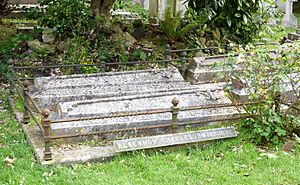
Swinburne's health became poor. In 1879, when he was 42, his friend Theodore Watts-Dunton took care of him. Watts-Dunton looked after him for the rest of his life at The Pines in Putney. Watts-Dunton also took him to the old town of Dunwich on the Suffolk coast several times.
Under Watts-Dunton's care, Swinburne became more settled. He died at The Pines on April 10, 1909, at the age of 72. He was buried at St. Boniface Church, Bonchurch on the Isle of Wight.
Swinburne's Writings
Swinburne wrote many famous poetic works. These include:
- Atalanta in Calydon (1865)
- Poems and Ballads (1866)
- Songs before Sunrise (1871)
- Poems and Ballads Second Series (1878)
- Tristram of Lyonesse (1882)
- Poems and Ballads Third Series (1889)
He also wrote a novel called Lesbia Brandon, which was published after he died in 1952.
Poems and Ballads
When Poems and Ballads was first published, it caused a stir. Some poems in it, like "The Leper" and "Laus Veneris," showed a Victorian interest in the Middle Ages. They had a medieval style and feel. Other well-known poems in this collection include "Hymn to Proserpine" and "The Triumph of Time".
Poetic Forms
Swinburne used many different poetic forms. One example is the Sapphic stanza, which has a special rhythm:
So the goddess fled from her place, with awful
Sound of feet and thunder of wings around her;
While behind a clamour of singing women
Severed the twilight.
Swinburne also created a poetic form called the roundel. This was a new version of the French Rondeau form. He included some in his book A Century of Roundels. He dedicated this book to Christina Rossetti. He wrote that he hoped people would enjoy his "hundred poems of nine lines each." Some people found these poems charming, while others thought they were just clever. One of his roundels, A Baby's Death, was turned into a song by the composer Sir Edward Elgar.
Swinburne was inspired by many other writers. These included William Shakespeare, Percy Bysshe Shelley, Catullus, and Victor Hugo. Swinburne was very popular in England during his lifetime.
After his first Poems and Ballads, Swinburne's later poetry often celebrated republicanism and ideas of freedom. This was especially true in his book Songs before Sunrise. For example, "A Song of Italy" was dedicated to the Italian leader Mazzini. "Ode on the Proclamation of the French Republic" was dedicated to Victor Hugo.
He continued to write love poetry, like his long poem Tristram of Lyonesse. However, these later love poems were less shocking than his earlier ones. His skill with words and rhymes remained excellent throughout his life.
See also
 In Spanish: Algernon Charles Swinburne para niños
In Spanish: Algernon Charles Swinburne para niños
- Flowers for Algernon also called Charly. Daniel Keyes homage paid to Algernon Charles Swinburne
- Patience, or Bunthorne's Bride (1881), a Gilbert-and-Sullivan opera that makes fun of Swinburne and his poetry
- Poems and Ballads
- Decadent movement
- Tristram of Lyonesse


